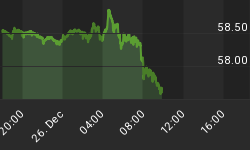That Wall Street has no understanding of what drives economies was made abundantly clear by its rampant confusion in late 2000 when it became obvious that the US economy was tanking. Whenever the economy slows slowdown or contracts Wall Street immediately targets consumer spending as the culprit. When the US economy booms, consumer spending is applauded as the saviour. The result is that eyeing consumer spending means that other trends are either misunderstood or largely ignored.
Economic folklore -- and that's all it is -- on Wall Street and in the mainstream media has it that consumer spending drove the boom. (I didn't mention the Bush boom because most journalists are pretending it doesn't exist). In support of this myth they point to the fact that consumer spending is about 66 to 70 per cent of GDP. Simple arithmetic therefore shows that should the largest component of GDP fall then GDP would contract.
The error here is in thinking that GDP measures gross expenditure when it does not. Spending on intermediary goods, goods that flow from one stage of production to another, is excluded. Include this spending and consumer spending as proportion of GDP falls enormously. Therefore it is total business spending that drives the economy, not consumer spending.
In 1928, for example, M. W. Holtrop calculated that consumer spending in the US was about 8.3 per cent of what was spent on producer goods, which also includes intermediary goods. On reflection this only makes sense. (See Friedrich von Hayek's Prices and Production, p. 47, Pub. Augustus M. Kelley 1967). Using the Survey of Current Business for 2002 I calculated that while GDP was $10.083 trillion dollars total outlays were over $18 trillion once spending on intermediary goods was accounted for. This means that consumer spending accounted for only a third or even less of US economic activity.
The net-value-added approach has the effect of treating the economy as consisting of two simple stages: the production stage and the consumption stage. In reality the economy consists of innumerable stages of production of staggering complexity. Today's economists were not the first to make the two-stage error, as one might call it. Adam Smith did the same thing when he wrote that
the value of goods circulated between the different dealers, never can exceed the value of those circulated between the dealers and the consumers; whatever is bought by the dealers, being ultimately destined to be sold to the consumers. (An Inquiry into the Nature and Wealth of Nations, Vol I, p 322, LibertyClassics, 1981).
Although classical economists who relied on Smith's authority have some excuse for being misled by this fallacy modern economists do not. In Prices and Production Friederich von Hayek described in considerable detail the complex nature of the production structure. On page 47 he also pointed out that Smith's error led to "a justification of the erroneous doctrines of the Banking School".
The importance of the above is vital if we are to understand what is happening at the moment (not just in the US but also in Australia) and why danger signals are overlooked. Despite evidence in 2000 that the capital goods industries in the US were cutting back, many commentators ignored this trend because consumer spending and retail sales were still holding up. So long as spending in these area was maintained or even increased, so it was reasoned, the economy was in no danger of sliding into recession.
But as I have explained before, credit expansion stimulates the capital goods industries into expanding output beyond the point that is economically justified. By the time this has been discovered these companies find themselves squeezed between rising costs and falling demand. The result is that production has be cut and labour laid off. According to this line of reasoning falling production means that expenditure on intermediary goods must drop. In other words, business spending is falling.
Now an initial fall in business spending need not register in GDP figures if consumer spending offsets it. This happens in two ways: 1. The factor payments that these companies have made are still working their way into consumer spending. 2. Consumer credit -- underpinned by credit expansion -- continues to sustain consumption. With consumer spending still growing, it's possible that employment in the consumer industries will still grow. This is what happened during the Clinton recession. Although production dropped consumer spending raced ahead.
Obviously this situation cannot be maintained. Eventually, a matter of months, consumer spending also starts to fall. Unless, of course, the Fed pumps up the money supply, as it did in late 1999, but these monetary injections can only have temporary effects because real economic forces will once again reassert themselves. Moreover, the profit squeeze could be so tight, as happened in the Great Depression and in Japan during the 1990s, that even extraordinarily low interest rates will fail to stimulate output.
The proper course of action will be to allow the recession to run its course. Governments can still take commendable action -- like cutting taxes and red tape. But if they want to deepen and prolong the depression all they need to do is lift taxes and try to fix prices and raise costs with a number of regulatory measures. In other words, exactly what Hoover and Roosevelt did and what Gore would have been inclined to do if he had won the election. Unfortunately Keynesianism still rules the roost, even if it does tend to do it from the shadows.
President Bush did the right thing in cutting capital gains taxes. This policy certainly raised the level of real savings and investment. On the other hand, the Fed's slack monetary policy also laid down the foundations for another recession that will once again be laid at the feet of the market or -- as Keynesians 'sagely' say -- the "animal spirits" of businessmen.
















